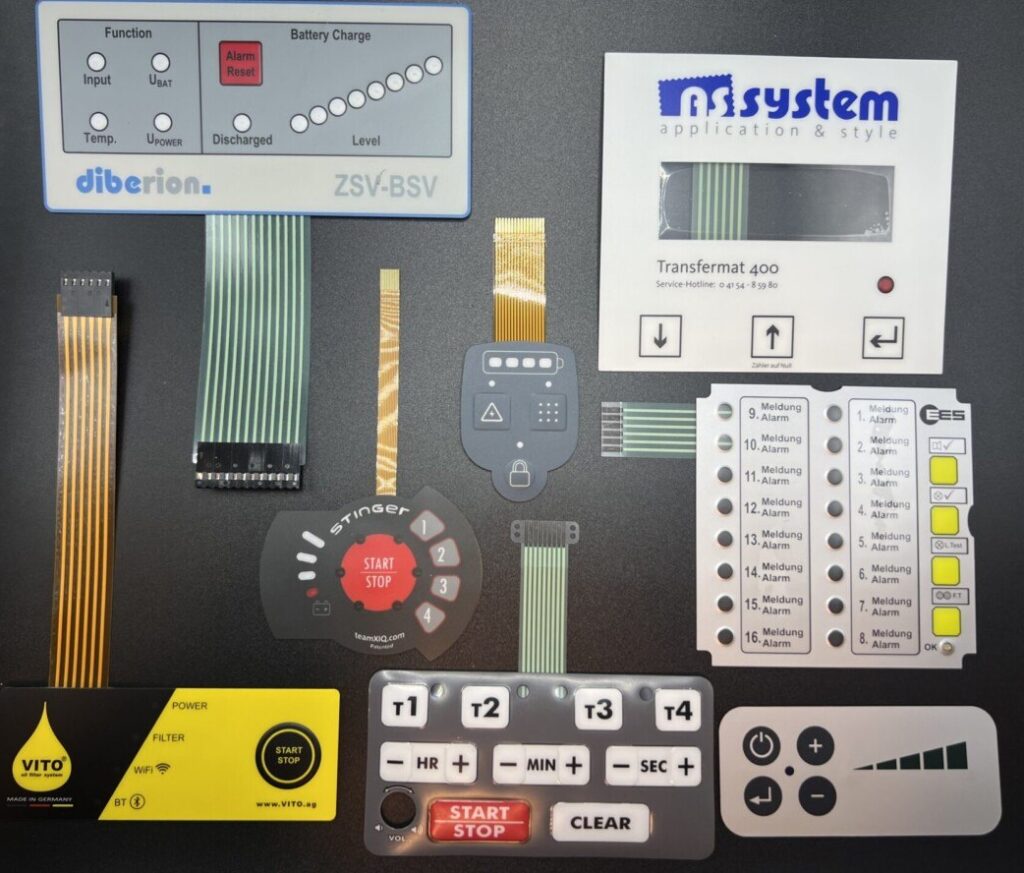Human-machine interface (HMI) designs often rely on membrane switches for reliable, low-profile, and cost-efficient input control. But choosing the right membrane switch construction is critical — especially when balancing cost, durability, electrical performance, and design complexity.
The three most common circuit constructions used in membrane switches are:
- Silver Flex (Screen-Printed Circuit)
- Copper Flex (Etched Circuit on Polyimide)
- PCB-Based Membrane Switches (Rigid FR-4 Circuit)
Each has strengths and limitations. This guide explains the differences and helps you determine which is best for your application.
What Are the Differences? (Quick Overview)
| Feature / Requirement | Silver Flex | Copper Flex | PCB-Based |
|---|---|---|---|
| Circuit Type | Printed silver ink on PET | Etched copper on polyimide | Copper traces on FR-4 rigid PCB |
| Flexibilidad | High | High | Low (Rigid) |
| Durabilidad | Medium | High | Very High |
| Cost | Lowest | Moderate | Highest |
| Tactile Feedback Options | Metal dome, polydome | Metal dome, polydome | Metal dome, rubber dome, scissor/hinge options |
| Backlighting Compatibility | Good | Excellent (due to precise pads) | Excellent |
| Typical Applications | Consumer, indoor equipment | Medical, industrial, automotive | High-performance, embedded electronics |
| Connector Type | Printed tail | Stiffened flex tail | Direct-to-board or integrated |
1. Silver Flex Membrane Switches
Silver flex circuits use screen-printed silver conductive paste on a polyester (PET) film.
Advantages
- Most cost-effective membrane switch circuit type
- Flexible and thin, ideal for compact spaces
- Simple to manufacture and customize
- Good for low-to-medium usage environments
- Works well with LED backlighting & metal domes
Limitations
- Not suitable for extreme environments (temperature, moisture, vibration)
- Silver traces may suffer migration under prolonged humidity
- Feature tolerances are less precise than copper flex
Best For
| Use Case | Why |
|---|---|
| Consumer electronics | Budget-friendly, reliable enough for typical usage |
| Indoor control panels | Stable environment = long lifespan |
| Medical home devices | Comfortable tactile experience, low cost |
2. Copper Flex Membrane Switches
Copper flex circuits use etched copper foil on a polyimide (Kapton®) film and are laminated with solder mask.
Advantages
- High durability and excellent electrical performance
- Fine-pitch routing → supports small components like LEDs & ICs
- Better resistance to humidity, temperature, and chemical exposure
- Ideal for harsh or outdoor environments
- Smooth integration with tail reinforcement and ZIF connectors
Limitations
- Higher cost than silver flex
- Slightly less flexible than PET-based silver circuits (but still bendable)
Best For
| Use Case | Why |
|---|---|
| Medical equipment | Sterilization-resistant & stable signals |
| Industrial control systems | High reliability in demanding environments |
| Automotive interior controls | Heat + vibration endurance |
3. PCB-Based Membrane Switches
These switches mount directly onto a rigid PCB (usually FR-4). Keypads, domes, and LEDs are assembled on the surface — sometimes alongside MCU and driver circuits.
Advantages
- Highest durability and reliability
- Excellent electrical performance with very high trace precision
- Allows complex circuits, backlighting, sensors, and microprocessors to be integrated directly
- Can combine with silicone rubber keypads, metal domes, or touch interfaces
Limitations
- Higher material & fabrication cost
- Rigid → not suitable for curved or flexible surfaces
- Heavier than flex-based designs
Best For
| Use Case | Why |
|---|---|
| Professional equipment | Reliability and lifespan are critical |
| Outdoor & ruggedized devices | Survives impact, moisture, vibration |
| Products requiring integrated electronics | MCU, LEDs, drivers all share one board |
How to Choose — Decision Framework
Ask yourself these key questions:
| Question | If Yes → Use This Type |
|---|---|
| Is minimal cost the priority? | Silver Flex |
| Will the device be used outdoors or exposed to moisture / temperature cycling? | Copper Flex or PCB |
| Does the design require fine-pitch LEDs or IC components? | Copper Flex or PCB |
| Is the hardware mounted in a rugged mechanical enclosure? | PCB |
| Does the surface need to bend or follow a curve? | Silver Flex or Copper Flex |
| Want longest lifetime + premium feel? | PCB |
Example Application Scenarios
| Product | Recommended Circuit Type | Notes |
|---|---|---|
| Home appliance control panel | Silver Flex | Cost-driven, indoor use |
| Hospital monitoring device | Copper Flex | Chemical & sterilization durability |
| Agricultural equipment control pad | Copper Flex or PCB | Shock + outdoor weather |
| Telecom base station panel | PCB-Based | Continuous duty + backlighting |
Conclusion
Choosing the correct circuit type in membrane switch design ensures:
- Reliable long-term performance
- Correct tactile feel for the operator
- Stable electrical functionality
- Appropriate cost and manufacturability
Silver Flex = Cost-effective & flexible
Copper Flex = Durable & precise for demanding environments
PCB-Based = Maximum reliability + advanced electronics integration
Need Help Selecting the Right Type for Your Project?
We manufacture:
- Silver Flex Membrane Switches
- Copper Flex Membrane Switches
- PCB-Based Keypad Assemblies
- Custom Silicone Rubber Keypads & HMI Solutions
We can:
✅ Review your application requirements
✅ Recommend the best circuit construction
✅ Provide samples or prototypes
→ Contact us to discuss your project requirements.
